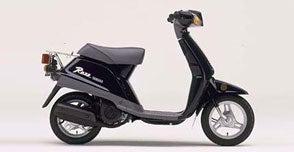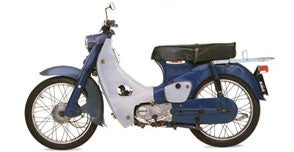|
Page 1 of 3 Local definitions of a MOPED

Brazil
In Brazil, the definition of moped ("ciclomotor" in Portuguese, but also known as "mobylette") and the regulations regarding its use has varied throughout the years. From 1985 to 1997, a moped was defined as human propulsion vehicle aided by an engine displacing less than 50 cc, no more than 3 hp, having a maximum speed of no more than 50 km/h and having pedals similar to those found in a bicycle. No license was required.
From 1997 onwards, the legal definition of moped changed to "a two or three wheeled vehicle having an internal combustion engine with displacement inferior to 50 cc and maximum factory speed of less than 50 km/h. The 1997 New Code of Transit also stated that any person aged 14 or older could ride a moped provided that person could read and be physically able. However, in 1998 the minimum age limit was changed to 18 years, since Brazilian Law doesn't allow minors to be criminally responsible, which contradicts the 1997 New Code of Transit, that states that being criminally responsible is a requirement to be able to get a license.
Note that by the current Brazilian regulations, electric mopeds are currently classified as "motorcycles", which require a type A driving license, as they have an electric motor instead of an internal combustion engine.
Canada
In Canada the Moped has been repealed from the Motor Vehicle Safety Regulations. Nevertheless the vehicle itself is still legislated within various provinces.
In Alberta, Canada, mopeds up to 49 cc and over 55 kilograms require a class 6 motorcycle licence. If they are between 35 and 55 kilograms a class 7 is required. In addition to this, they must not have a driver-operated transmission. They are allowed to carry more than one person. Mopeds are subject to all of the same traffic laws as other vehicles, and all riders must wear helmets.
In Ontario, Canada, "a moped is a motor-assisted bicycle fitted with pedals that can be operated at all times and has a maximum speed of 50 km/h."[5] A motor assisted bicycle is a bicycle:
- that is fitted with pedals that are operable at all times to propel the bicycle,
- that weighs not more than fifty-five kilograms,
- that has no hand or foot operated clutch or gearbox driven by the motor and transferring power to the driven wheel,
- that has an attached motor driven by electricity or having a piston displacement of not more than fifty cubic centimetres, and
- that does not have sufficient power to enable the bicycle to attain a speed greater than 50 kilometres per hour on level ground within a distance of 2 kilometres from a standing start; (“cyclomoteurâ€)[6]
Since 28 November 2005 moped drivers require either a full M licence or a restricted class M licence to legally ride on road in Ontario. Prior to that date riders only required a G licence. The G licence is a "general" licence for automobile drivers such as cars, small vans and trucks.

Denmark
Mopeds in Denmark are divided into "Small mopeds" and "Big mopeds", 'Small' mopeds have a speed limit of 30 km/h, and 'Big' mopeds have one on 45 km/h. A moped license is needed and the driver must be at least 16 to operate a small one. A car driver's or motorcycle license is needed and the driver must be at least 18 years old to drive a big one. All new mopeds (both types) bought after 1 June 2006 must be registered with a license plate, and have insurance. The older models are not required to have a license plate.
Both models have a maximum of 1-1.2 bhp (750-890 W) and 50 cc but nearly 75% of all Danish mopeds are illegally unrestricted.
|











